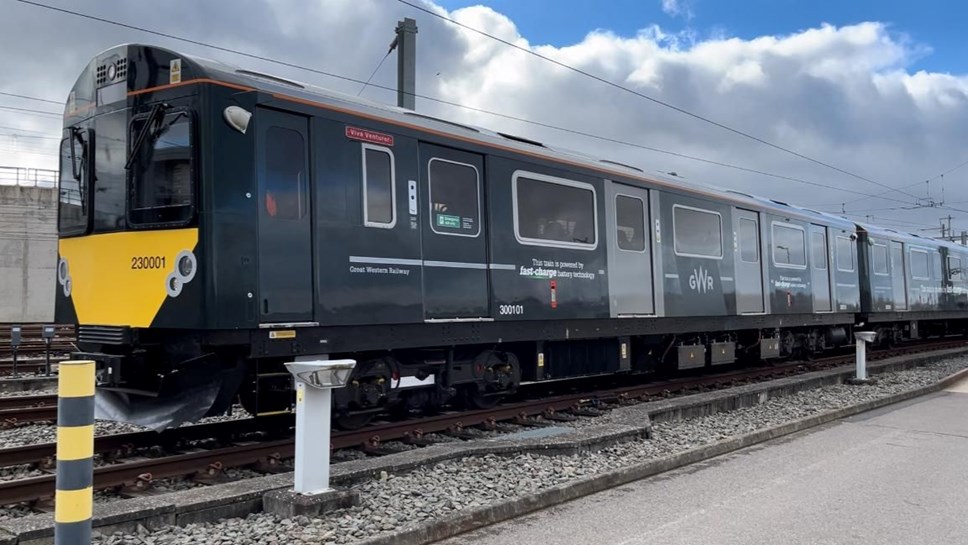
Great Western Railway’s battery train sets new distance record
Great Western Railway’s innovative fast-charge battery trial has achieved another significant step – just days after laying claim to a battery train UK distance record without recharging.
The train demonstrated its capability on Wednesday by travelling a UK record of 86 miles (138km) on battery power alone and without recharging.
Today the Class 230 battery train completed a 70-mile move from Long Marston to Reading Train Care Depot – using just 45 per cent of its battery capacity. GWR’s team of specialist engineers on board the train claim it could have travelled more than 120 miles on a single charge.
While at Reading, the train will undergo compatibility testing and preparedness for future maintenance and servicing requirements.
GWR Engineering Director Dr Simon Green said:
“We were delighted by how the battery train performed today and during its series of test runs. In fact, it’s fair to say it has surpassed the expectations of our team of engineers.
“Achieving these distances gives us great confidence as we press forward with this industry-leading fast-charge technology.
“It’s also worth noting that in reaching the 86 miles on Wednesday, the train was operating in a real-world environment, at speeds of up to 60mph, stopping and starting over a hilly route, with elevation changes of up to 200m.”
The train exceeded the 84 miles (135km) recorded by a Stadler Class 777 under test conditions in 2022 – believed to have been the greatest distance travelled by a battery train designed for the UK.
GWR’s fast-charge technology has been designed to solve the problem of delivering reliable, battery-only trains capable of fulfilling timetable services on branch lines, eliminating the use of diesel traction and helping to meet the Government and wider rail industry’s target to reach net-zero carbon emissions by 2050.
The use of batteries for extended operation has typically been constrained by their range and meant widespread implementation has, until now, not been possible. It also negates the need for overhead electric lines which are expensive, time consuming to install and impact the landscape.
At West Ealing, where the technology will be trialled in a real-world environment for the first time this spring, the train will charge for just 3 ½ minutes before restarting its journey on the Greenford branch line.
GWR has already carried out simulations on other branch lines in the Thames Valley to explore how it could be rolled out even further in the future. This could reduce GWR emissions alone by over 1,700 tons of CO2e per year.
It is hoped the technology could one day see battery-powered trains in operation across the UK’s approximately 2,000 miles of 80-plus branch lines.
Background
In February 2022, GWR signed a deal with Vivarail to trial new battery-charging technology designed to support the wider introduction of battery-powered trains on the UK’s rail network.
After Vivarail entered administration in December 2022, GWR agreed contracts to buy intellectual property, rolling stock and equipment relating to the fast-charge technology.
Charging rails and lineside battery banks have been installed at West Ealing in preparation for the start of the trial on the Greenford branch line.
Once the trial commences it will run in non-passenger service alongside scheduled passenger services.
Record run: how GWR's battery train clocked up 86 miles
Long Marston to Evesham West Junction, reverse, then to Moreton-in-Marsh = 25.6 miles
Moreton-in-Marsh to Honeybourne North Junction, reverse, then to Honeybourne Staff Hut and reverse again = 11.4 miles
Honeybourne Staff Hut to Honeybourne North Junction, reverse, then to Moreton-in-Marsh = 10.9 miles
Moreton-in-Marsh to Evesham West Junction, reverse, then return to Honeybourne Staff Hut via Honeybourne North Junction, then reverse again = 22.2 miles
Honeybourne Staff Hut to Evesham West Junction, reverse, then return to Long Marston via Honeybourne North Junction = 15.1 miles
Shunting to and from the maintenance shed to the entrance gate at Long Marston = 0.8 miles
Contact Information
John Carter
Media and Communications Manager
Great Western Railway
0845 410 4444
Notes to editors
Pictures, from top: The battery train at Reading Train Care Depot; engineers at Reading station; the train at Reading depot
First Greater Western Limited, trading as “Great Western Railway” (GWR), operates trains across the Great Western franchise area, which includes South Wales, the West Country, the Cotswolds, across southern England and into London. GWR provides high speed, commuter, regional and branch line train services, and before the covid-19 pandemic helped over 100 million passengers reach their destinations every year. GWR has been awarded a National Rail Contract to continue operating the Great Western network, which shall run up to 21 June 2025, with the potential for a further three years at the Secretary of State’s discretion. Find out more here: https://www.gwr.com/about-us.


